Driving on German roads is very well regulated and if you don’t adhere to the rules you will get penalty points against your name as well as hefty fines. When you reach a certain amount of points (currently 8) your licence can be suspended. Ignorance of road rules is not an excuse.
The ADAC (Allgemeiner Deutscher Automobil-Club) website has the following information:
- a list of the Traffic signs – the descriptions are in German
- the Traffic Rules(in German)
- The signs you have to learn very fast are the Road priority signs, Wikipedia has a list of road signs in English, but this is not an official German authority site
According to ADAC, radar detectors are prohibited and if you use them you risk a fine. Regardless of whether it is integrated into the Navi system or installed on your mobile phone, or an external device. You are however allowed to download such apps on your smartphone. You can use it before your journey to inform yourself where the speed cameras are, but you are not allowed to use them while driving. If you are stopped during traffic checks, and the app is active you will get a fine.
Some basic road rules
| Vehicle Insurance | Compulsory |
| Children | Children up to 12 years of age who are smaller than 1.5 metres are only allowed to ride in a child seat. There are various models depending on the child’s age and height. The right selection will determine your child’s safety. |
| Emergency Lanes | ” Die Rettunsgasse muss bereits gebildet werden, sobald der Verkehr stockt und nicht erst, wenn die Rettungskräfte mit Blaulicht und Martinshorn kommen. “ The emergency lane must be formed as soon as the traffic stops and not only when the emergency services come with blue light and a siren. |
| First aid kit in the vehicle DIN 13164 | In your car you must have a safety vest (it is even better if you have one for each passenger), a warning triangle and an up to date first aid kit. As from Feb 2022 – two mouth and nose covers must be included in your kit |
| Reflective vest | In your car you must have a safety vest (it is even better if you have one for each passenger), a warning triangle and an up to date first aid kit. |
| Warning triangle | In your car you must have a safety vest (it is even better if you have one for each passenger), a warning triangle and an up to date first aid kit. |
| Fuel | Running out of fuel on the Autobahn is an offence and you can get a fine. |
| In the case of an accident | In an emergency with injured persons, you should immediately phone the number 112. In a non-emergency, you should phone 110 for the police. Remain at the accident site until the police have arrived. Whoever has damaged a parked car and cannot reach the owner should inform the police and must wait until the accident has been reported. Leaving a note is not enough. Causing an accident and leaving the scene is considered a hit and run and will be punished with a monetary fine or imprisonment up to three years. If your car breaks down on the highway, put on your emergency vest, set up the warning triangle and wait for help in safety behind the guardrail. |
| Motorcycle helmet | If you drive a moped, scooter or motorcycle, you must always wear a helmet. The same applies to the passenger. |
| Roundabout / Traffic Circle | Give way to the left unless signed otherwise. |
| Seat belts | Compulsory for all passengers. |
| Winter Tyres | Compulsory in Winter conditions. Rule of thumb – O bis O (Oktober bis Ostern) |
 | Priority road (priority at all following intersections up to an end-of-priority-road, yield or stop sign). |
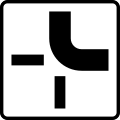 | Sign at an intersection and a definition of the priority. The Thick line has priority. Note that vehicles coming from west must give way to vehicles coming from south (due to right-hand priority). |
Types of road signs

Warning Signs
Be cautious on the road and watch for warning signs. These red-triangle signs with white backgrounds and black pictograms offer important safety information and should be noted to avoid potential dangers while driving.
Regulatory signs
Regulatory signs are vital for road safety. They give clear orders to drivers, reducing the chance of accidents and ensuring compliance with traffic rules. In Germany, circular signs with red indicate prohibitive actions and and blue circles indicate prescriptive actions. These signs are non-negotiable and must be followed to avoid penalties and legal consequences.
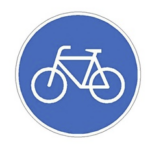

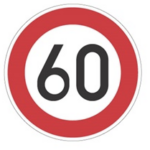
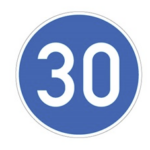
How to build an emergency lane

Insults on the road
Everyday traffic situations can quickly escalate in road users harassing or throwing swear words at each other, and reacting aggressively.
Derogatory gestures like showing someone a middle finger or using swear words like “A…hole” are not only rude and offensive, but they can also constitute a criminal offence (§ 185 StGB).
- Insults in traffic are punished with 20- 30 daily rates (A daily rate is your monthly net income divided by 30, so you could for example get a fine for your daily rate x 20 )
- In special cases, a driving ban can also be imposed
- You do not lose any “Flensburg” points
Driving in winter
Winter brings new hazards and regulations for drivers, To avoid fines, it’s vital to stay informed about the laws and regulations. Below is a rules you need to be aware of in winter
Fines - 2024
-
Engine Running €80
Let your car engine run to defrost the windows. "Standheizung" is allowed
-
Lights €20
Driving without your lights on. Switching your lights on helps with visibility
-
Snow on car €25
Snow on your car's hood or roof can blow onto other cars' windscreens causing dangerous conditions and accidents. Be a responsible driver by taking preventive measures like removing snow before driving.
-
No winter tyres €60
Driving without winter tyres despite wintery road conditions. In addition to a fine you will also get on point against you.
-
Speeding €100
Not adjusting your speed in poor visibility conditions. In addition to a fine you will also get on point against you.
-
Window not clear €10
For safe winter driving, clear all windows of frost and snow to maintain optimal visibility. Neglecting to do so can be dangerous, obstructing your vision and preventing you from seeing potential hazards.
References
Resources on the web
- Driving in Germany
- Gettingaroundgermany
- Brain’s guide to getting around Germany. Traffic signs and signals
- THE MASTER DRIVERS GUIDE TO DRIVING IN GERMANY – This is a PDF file with road rules, not sure who the author is and how up-to-date it is
Related content
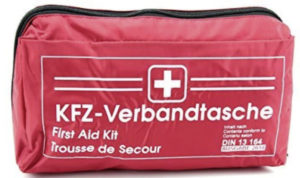
First aid kit
The traffic law in Germany stipulates that all drivers must carry a first aid kit (Verbandkasten) in their vehicle. The contents of your first aid kit must comply with the DIN 13164 standard. Motorcycles and tractors are exempt. Quad bikes are not.The current (2022) fine for not carrying a first

Winter Tyres
The winter conditions in Germany can make the roads dangerous and slippery to drive on.Winter conditions are for example black ice, slippery snow, slush, slippery ice or frost. (Glatteis, Schneeglätte, Schneematsch, Eis- und Reifglätte). According to German law (November 2010), you are not allowed to drive without Winter tyres on

Driving and Driver’s licences
If you are only visiting, you need an International driver permit which you can apply for at the AA in South Africa If you stay longer, you can drive legally for 6 months with your South African licence and an Internationallicense, after that you must convert your SA licence to



You must be logged in to post a comment.